Htc one x best firmware. HTC One X - Unlocking the bootloader, installing recovery, obtaining root rights, flashing Custom ROM
One is no longer the latest innovation from the manufacturer, having found a worthy successor, but the smartphone is still highly popular due to its functionality and reliability. If you like to use the device's capabilities to the maximum, you should update the OS in a timely manner HTC One, which is possible in two scenarios: using OTA updates, or using custom ROMs.
By choosing any of the procedures, the user will be able to access all the latest innovations, as well as improve the performance of the device. It's worth pointing out that updates often open up new opportunities for personalization. Now let's take a closer look at how to update without errors. operating system HTC One.
It's no secret that automatic OTA updates for HTC One have always been, and will continue to be, the simplest method, but it's worth paying attention to this nuance: OTA updates do not arrive on all devices of the same model at the same time. This factor depends on the operator, manufacturer and region where the smartphone itself is located. If OTA updates for HTC One are not yet ready, but can already be found online, self-installation is possible. In this situation, the device warranty remains valid. Another option when you need to install official updates manually is to switch from unofficial custom to official Android OS firmware from HTC.
If you wish to receive additional features and significantly increase the performance of your HTC One, it is worth installing a custom ROM. This implies the need and installation of a custom recovery image or. The price for increased capabilities is a factory warranty. However, you can return it by downloading and installing the official latest version HTC One firmware.
What will you need?
PC or laptop
Temporarily disabling antivirus protection
Charge your smartphone battery to at least 50%
Backups significant data and settings, including Nandroid backup
Make sure that the updates you receive are specific to this HTC One model
Awareness of the share of risk and personal responsibility for installing a custom ROM.
Updating your HTC One device using OTA
1. Make sure HTC One is connected to your WiFi network.2. Go to the smartphone menu, open the settings option.
3. Click on the System option, sub-item HTC Software Updates.
4. Select Check now.
5. If there are fresh updates, install them on HTC One.
6. The installation process will be automatically completed after the smartphone restarts.
Manually updating HTC One
1. Install on a PC corresponding to your HTC One model.2. Following the instructions, launch the Update Utility.
3. Using a USB cable, connect the HTC One to the computer.
Updating HTC One using custom firmware
1. (if there are no applications in this firmware) download to a personal computer.2. There is no need to unpack them.
3. Connect the smartphone to the PC and transfer both files to HTC One.
4. Turn off the smartphone and reboot into recovery mode.
5. We do a wipe ( wipe data factory reset and wipe cache partition, as well as wipe dalvick cache from the menu section advanced).
6. Go back to the main menu, select the following options: install zip from SD card and choose zip from SD card.
7. First install the update file, and then Gapps.
8. Go back to the main menu of recovery mode and reboot HTC One.
When applying this theoretical material in practice, one should not forget about the high degree of responsibility for this procedure, which rests entirely with the user mobile device, at his own risk.
Zhovten 27, 2014
Since the MIUI firmware is not stock for NTS smartphones, installing it is fraught with some difficulties. This can lead to data loss on the NTS smartphone and other unpredictable consequences. Neither Xiaomi nor our website miui.com.ua is responsible for the consequences of your actions. Therefore, be careful and make a complete backup of your data, write down the IMEI of your smartphone and find out the address of the nearest service center :)
But let's hope everything goes well, because... There is nothing complicated in the firmware, it just takes time, attentiveness and perseverance.
NTS company installs its own add-on on its smartphones. Android system called HTC Sense, and has a very negative attitude in trying to get root rights, unlock the bootloader and change the shell to something else. Therefore, there will be no easy path.
You must understand that the procedure will take you at least half an hour, so set aside an hour of time in advance so as not to rush and do everything consistently and correctly.
Let's begin. First, let's unlock the bootloader. We will need a computer with internet and an HTC One X smartphone.
First of all, download and install HTC Sync if it is not installed on your computer.
Please write a real email address, because... You will receive confirmation of registration. In the email you receive, click the link and confirm that you are a human and want to get an account on HTC.
2. Do not unpack it, but put it in the root of the internal memory of the HTC One X smartphone.
3. Boot into Bootloader (Volume - and Power button)
4. Select the item Recovery, after loading the recovery, select the item Install zip from sd card
5. Point to the downloaded archive and confirm the choice.
6. After installation, select Reboot system now.
Now you are a super user! And up to MIUI firmware There are only a few steps left on HTC One X.
Now let's flash the firmware itself.
1. Download the current one for HTC One X
2. Without unpacking the archive, put it in the root of the smartphone’s internal memory.
3. Boot into recovery (steps 3-4 above)
5. Destroy the data (first you need to copy the files to your computer, and your contacts to Google or NTS, or to your computer using HTC Sync)
– wipe data\factory reset
– wipe cache
– wipe davlic cache
6. We start the firmware from scratch. Select an item Install zip from sd card
7. Specify the archive with the firmware and confirm the choice. The installation may take some time. Once the installation is complete, the following message will appear: Install from sd card successfully completed.
If you had another smartphone, this would all be over. But the owners of NTS are not looking for easy ways.
We return to the computer again. Extract the file from the archive with the firmware boot.img and put it in a folder C:/Android
In the recovery menu select Advanced Power Menu and onwards – Reboot into bootloader
You should still have it open Windows console. If not, open it again (Start-Run-cmd-Enter-CD C:\Android)
Type the command fastboot flash boot boot.img and press Enter
Select Reboot on your smartphone, and if it boots successfully, MIUI should already be running on it.
For the HTC one x device, the firmware contains everything necessary updates. The official htc one x firmware is installed very easily and quickly. You can download htc one x firmware from the Internet. The One X from HTC is a powerful flagship device with a wonderful design and simply stunning technical characteristics and opportunities.
This is one of the most powerful gadgets of its time.
Performance
This is a very powerful gadget, equipped with a permanent memory of 32 GB, based on Android vr 4.0 with high-quality Sense vr 4. The amount of RAM, which is 1 GB, is also not the weakest. The device has a high-power quad-core processor, each core of which has about 1.5 GHz and an additional core for low-frequency processes. Htc one x firmware contains a wide range of the most modern software. The gadget has two excellent cameras, one of which is on the front side, the other, eight megapixel, on the back.
FOTA update
The official htc one x firmware can be easily installed using FOTA update mode online via GPRS or Wi-Fi firmware. The smartphone must have free place and a 100% charged battery. You need to keep in mind that the FOTA update is only suitable for “locked” devices, otherwise you will not be able to flash the phone.
The firmware process is extremely simple. The update is downloaded and then installed in automatic mode. You need to be prepared for the fact that the operation time may be long.

Custom firmware
Installing various custom firmware is quite complex and can be individual for each individual version or build. You need to unlock the gadget, download the htc one x firmware, placing it in C:\Android. Reboot the phone in bootloader mode by holding down the power button for 10 seconds, and after the process starts, hold the volume down. Then select Fastboot, and then connect to the PC.
Using command line, enter the firmware folder and execute “fastboot flash recovery file *.img”, then reboot as before. Use the Volume and Power buttons to select Recovery. The device will reboot again. In the menu item you need to select backup and wait for the operation to complete. Then reboot using the “Reboot System Now” function.
Today we will install custom firmware on one of best phones company - HTC One X review which you can read on our website. In this manual, I will provide you with the most popular firmware for this smartphone, and also give you a link so that, in case something happens, you can choose the right one for yourself. Go.
HTC One X firmware- step-by-step instruction
7. The next step is to select Install zip from sdcard ->Choose zip from sdcard -> look for where we put the downloaded firmware, select and press (do not press!) the power button on the smartphone.
8. Patience. Waiting for it to install firmware for HTC One X.
9. When the installation is finished, something like “blah blah blah completed” will appear.
11. You need to reboot the phone: go to the bootloader menu: Advanced Power Menu -> Reboot into bootloader
12. With USB cable connect One X to the PC, then open the command line (CMD) and write
press "Enter".
13. Then we write there:
and again "Enter".
14. That’s it, the reboot remains, in the bootloader we select the “REBOOT” item.
Every smartphone owner wants to make their device better, turn it into a more functional and modern solution. If the user cannot do anything with the hardware, then anyone can improve the software. HTC One X is a high-end phone with excellent technical characteristics. How to reinstall or replace the system software on this device will be discussed in the article.
Considering the NTS One X from the point of view of the firmware capabilities, it should be noted that the device in every possible way “resists” interference in its software part. This state of affairs is due to the manufacturer’s policy, therefore, before installing the firmware, you should pay special attention to studying the concepts and instructions and only after fully understanding the essence of the processes proceed to direct manipulations with the device.
Every action carries a potential danger to the device! Responsibility for the results of manipulations with the smartphone lies entirely with the user who carries them out!
As with other Android devices, the success of HTC One X firmware procedures is largely determined by proper preparation. We carry out the following preparatory operations, and before carrying out actions with the device, we thoroughly study the proposed instructions, download the necessary files, and prepare the tools that are supposed to be used.

Drivers
The simplest way to add interaction components to the system software tools with memory partitions One X is HTC installation Sync Manager - proprietary program manufacturer to work with your smartphones.


Backing up information
Using the methods described below for installing system software into the device in question involves erasing user data contained in the smartphone. After installing the OS, you will have to restore the information, which is impossible without a previously created backup. The official way to save data is as follows.


Necessary
To operate with HTC One X memory partitions, in addition to drivers, the PC as a whole will need functional and convenient software tools. Be sure to download and unpack the package with and into the root of drive C:. Below in the description of methods we will not dwell on this issue, implying that Fastboot is present in the user’s system.

Run in different modes
For installation of various system software you will need to switch the phone to special operating modes - "BootLoader" And "Recovery".


Unlocking the bootloader
The instructions for installing modified firmware below assume that the device's bootloader is unlocked. It is recommended to carry out the procedure in advance, and this is done using the official method offered by HTC. And it is also assumed that before performing the following, Sync Manager and Fastboot are installed on the user’s computer, and the phone is fully charged.
- Follow the link to the official website of HTC Developer Center and press the button "Register".
- Fill out the form fields and press the green button "Register".
- Go to your mail, open the letter from the HTCDev team and click on the link to activate your account.
- After activating your account, enter your username and password into the appropriate fields on the HTC Developer Center web page and click "Login".
- In area "Unlock bootloader" click "Get Started".
- On the list "Supported Devices" you need to select all supported models and then use the button "Begin Unlock Bootloader" to proceed to further steps.
- We confirm our awareness of the potential danger of the procedure by clicking "Yes" in the request window.
- Next, check both checkboxes and press the button to go to unlocking instructions.
- In the instructions that open, skip all the steps

and scroll through the instructions to the very end. We only need a field to insert an identifier.
- We put the phone into mode "Bootloader". In the list of commands that opens, select "FASTBOOT", then connect the device to the PC using a USB cable.
- Open the command line and write the following:
cd C:\ADB_Fastboot

- The next step is to find out the device ID value required to obtain unlock permission from the developer. To obtain information, you need to enter the following in the console:
fastboot oem get_identifier_token

and start executing the command by pressing "Enter".
- Select the resulting set of characters using the arrow buttons on the keyboard or with the mouse,
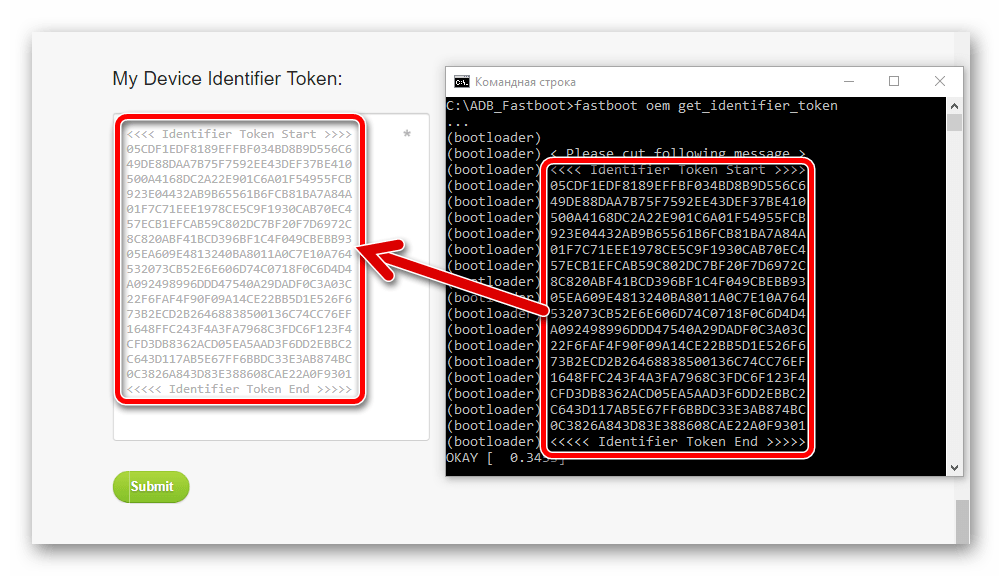
and copy the information (using the combination "Ctrl" + "WITH") in the appropriate field on the HTCDev web page. It should look like this:

To go to the next step, click "Submit".
- If the above steps are completed successfully, we receive an email from HTCDev containing Unlock_code.bin– a special file for transferring to the device. Download the file from the letter and place the downloaded file in the Fastboot directory.
- We send the command via the console:
fastboot flash unlocktoken Unlock_code.bin
- Executing the command above will result in a prompt appearing on the device screen: "Unlock bootloader?". Place a mark next to "Yes" and confirm readiness to start the process using the button "Inclusion" on the device.
- As a result, the procedure will continue and the Bootloader will be unlocked.
- Confirmation of successful unlocking is the inscription "***UNLOCKED***" at the top of the main mode screen "Bootloader".








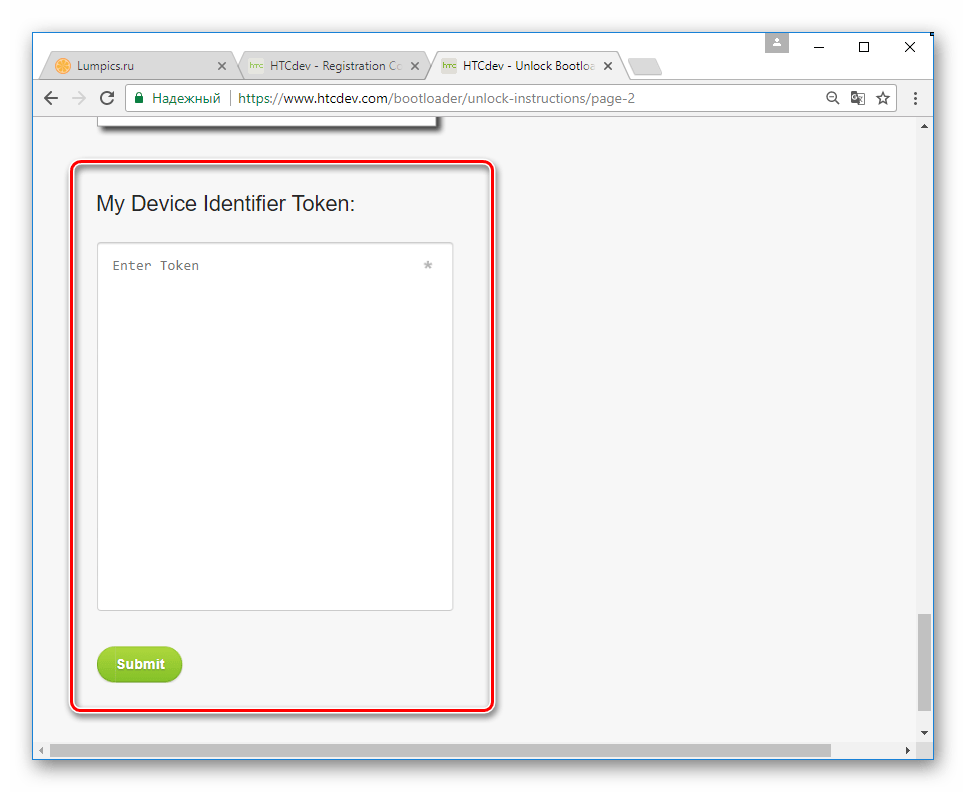


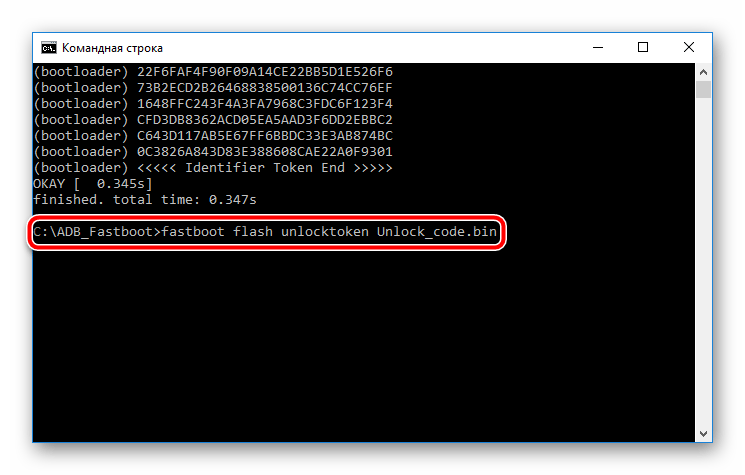



Installing custom recovery
For any serious manipulations with the HTC One X system software, you will need a modified recovery environment (custom recovery). Provides a lot of possibilities for the model in question. Let's install one of the ported versions of this recovery environment into the device.


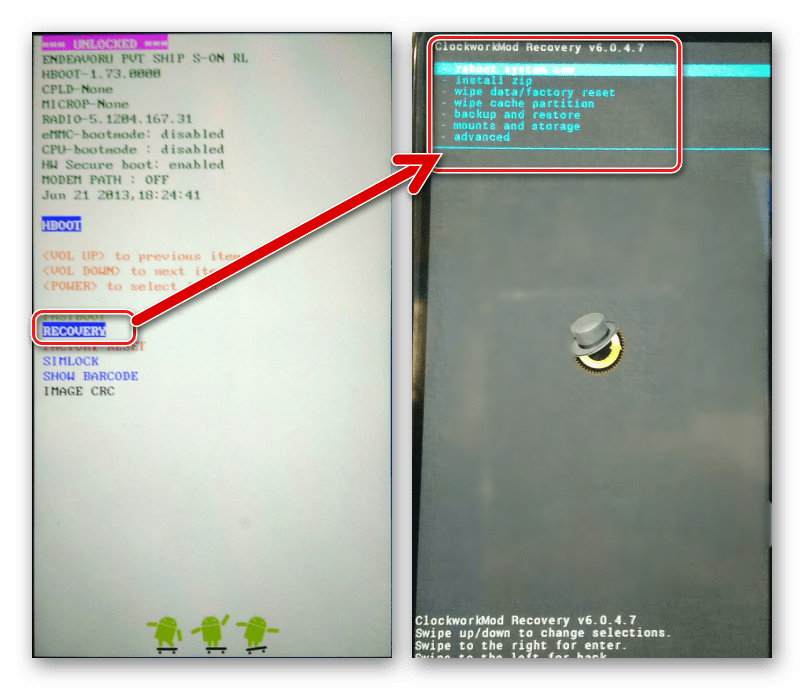
Firmware
In order to bring certain improvements to the software part of the device in question, upgrade the Android version to a more or less current one, and also diversify the functionality, you should resort to using unofficial firmware.
To install custom and ports, you will need a modified environment, which can be installed according to the instructions above in the article, but first you can simply update the version of the official software.
Method 1: Android application “Software Updates”
The only method of working with the smartphone system software officially approved by the manufacturer is to use the tool built into the official firmware "Software Updates". During the life cycle of the device, that is, while system updates were released from the manufacturer, this feature regularly reminded itself of itself with persistent notifications on the device screen.

Today to update official version The OS or make sure that the latter is up to date, you need to do the following.


Method 2: Android 4.4.4 (MIUI)
Software from third-party developers can breathe new life into your device. The choice of a modified solution lies entirely with the user; the available set of different packages for installation is quite wide. As an example, below we use the firmware ported by the MIUI Russia team for HTC One X, which is based on Android 4.4.4.

- We install the modified recovery using the method described above in the preparatory procedures.
- Download the software package from the official web resource of the MIUI Russia team:
- Place the zip package in internal memory apparatus.
- Loading the phone into "Bootloader", further in "RECOVERY". And we ALWAYS make a backup by selecting the corresponding items in CWM one by one.
- We do wipes (cleaning) of the main system partitions. To do this you will need an item "wipe data/factory reset".
- Let's go to "install zip" on the main CWM screen, indicate to the system the path to the zip package with the software, after selecting “choose zip from storage/sdcard” and start installing MIUI by clicking “Yes – Install...”.
- We are waiting for the success confirmation message to appear - "Install from sd card complete", back to main screen environment and select "advanced", and then reboot the device into Bootloader.
- Unpack the firmware with an archiver and copy it boot.img to the catalog from Fastboot.
- We put the device into mode "FASTBOOT" from the Bootloader, connect it to the PC if it was disconnected. Run the Fastboot command line and flash the image boot.img:
fastboot flash boot boot.img
- Reboot into the updated Android using the item "REBOOT" on the menu "Bootloader".
- You will have to wait a bit for the MIUI 7 components to initialize, and then carry out the initial system setup.

It is worth noting that MIUI on HTC One X works very well.


Additionally. If the smartphone does not boot into Android, which makes it impossible to copy packages into memory for further installation, you can use OTG capabilities. That is, copy the package from the OS to a USB flash drive, connect it via an adapter to the device and, during further manipulations in recovery, indicate the path to "OTG-Flash".







Method 3: Android 5.1 (CyanogenMod)
In the world of Android devices, there are not many smartphones that have successfully performed their functions for more than 5 years and at the same time are popular with enthusiastic developers who successfully continue to create and port firmware based on new versions of Android.

Probably, HTC One X owners will be pleasantly surprised that a fully functional Android 5.1 can be installed on the device, but by doing the following, we get exactly this result.
Step 1: Install TWRP and new partition
Among other things, Android 5.1 brings with it the need to re-partition the device’s memory, that is, change the size of partitions to achieve best results in terms of stability and the ability to perform functions added by developers to the new version of the system. You can repartition and install a custom one based on Android 5 only using a special version.


Step 2: Installation of custom
So, the new markup is already installed on the phone, you can proceed to installing custom firmware with Android 5.1 as the basis. Let's install CyanogenMod 12.1 - an unofficial firmware port from a team that needs no introduction.


- "Platform" - "ARM";
- "Andriod" — "5.1";
- "Variant" - "nano".
To start downloading, press the round button with the image of an arrow pointing down.




Unpack the package cm-12.1-20160905-UNOFFICIAL-endeavoru.zip and move boot.img from it to the catalog with Fastboot.

Fastboot flash boot boot.img
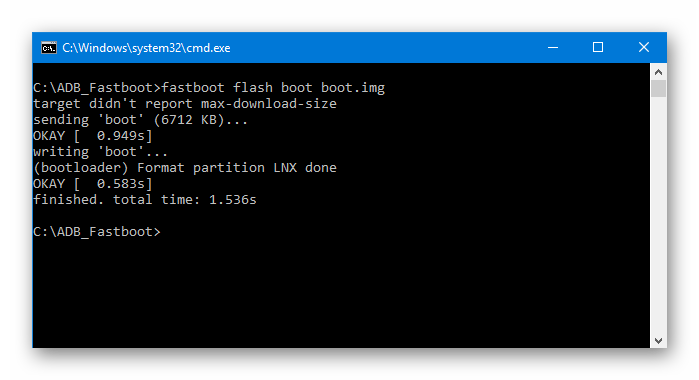
Then we clear the cache by sending the command:
fastboot erase cache



and enjoy the new work Android versions, modified for the smartphone in question.

Method 4: Official firmware
If there is a desire or need to return to the official firmware from HTC after installing custom ones, you need to again turn to the capabilities of modified recovery and Fastboot.

- Download the version of TWRP for the “old markup” and place the image in the Fastboot folder.
- Download the package with the official firmware. The link below is OS for the European region version 4.18.401.3.
- Download the image of the HTC factory recovery environment.
- Unpack the archive with the official firmware and copy it boot.img from the resulting directory to the folder with Fastboot.

We put the file there recovery_4.18.401.3.img.img, containing stock recovery.
- Flash boot.img from official firmware via Fastboot.
fastboot flash boot boot.img - Next, install TWRP for the old markup.
fastboot flash recovery twrp2810.img
- We disconnect the device from the PC and reboot into the modified recovery environment. Then we go the next way. "Wipe" - "Advanced Wipe"- mark the section "sdcard" - "Repair or Change File System". We confirm the start of the change process file system button "Change File System".
- Next, press the button "FAT" and move the switch "Swipe to Change", and then wait for the formatting to finish and return to the TWRP main screen using the button "Home".
- Select an item "Mount", and on the next screen - "Enable MTP".
- Mounting done in the previous step will allow the smartphone to be identified in the system as a removable drive. We connect One X to the USB port and copy the zip package with the official firmware to the internal memory of the device.
- After copying the package, click "Disable MTP" and return to the main recovery screen.
- We clean all partitions except "sdcard", going through the points: "Wipe" - "Advanced Wipe"- selection of sections – "Swipe to Wipe".
- Everything is ready to install the official firmware. Choose "Install", indicate the path to the package and begin the installation by sliding the switch "Swipe to Confirm Flash".
- Button "Reboot System", which will appear after the firmware is completed, will reboot the smartphone into the official version of the OS; you just need to wait for the latter to initialize.
- If desired, you can restore the factory recovery with the standard Fastboot command:
fastboot flash recovery recovery_4.18.401.3.img
And also block the bootloader:
fastboot oem lock
- Thus, we get a completely reinstalled official version of the software from HTC.












In conclusion, I would like to once again note the importance of scrupulously following the instructions when installing system software on the HTC One X. Carry out the firmware carefully, evaluating each step before it is carried out, and achieving the desired result is guaranteed!




